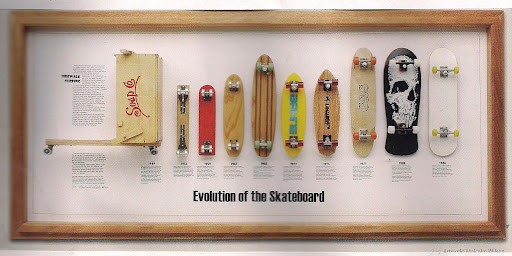 You might not know it by looking at the ultra-light, super strong skateboards that are being flipped and spun beneath the feat of extreme athletes today, but the very first skateboards were anything but high performance. Back in the 1940’s and 50’s skateboards were made by attaching roller skate wheels to wooden boxes or planks. As technology and construction materials evolved, so did the performance levels of skateboards, helping to propel the sport of skateboarding through the boom years of the early 70’s, to the heyday of skateboard magazines and videos in the 80’s and 90’s, and into the X-Games era of today.
You might not know it by looking at the ultra-light, super strong skateboards that are being flipped and spun beneath the feat of extreme athletes today, but the very first skateboards were anything but high performance. Back in the 1940’s and 50’s skateboards were made by attaching roller skate wheels to wooden boxes or planks. As technology and construction materials evolved, so did the performance levels of skateboards, helping to propel the sport of skateboarding through the boom years of the early 70’s, to the heyday of skateboard magazines and videos in the 80’s and 90’s, and into the X-Games era of today.
The Beginning
Skateboarding was originally developed by surfers in California who were looking for a similar activity that they could do on land when the waves were flat. “Sidewalk surfing,” as skateboarding was originally called, was initially little more than long-haired surf bums struggling to ride 2x4s on steel roller skate wheels. Rickety and unstable, these early skateboards were extremely difficult to ride, let alone turn or maneuver. However, the stage had been set for skateboarding to really catch fire by the end of the 1960’s.
The Golden Era of Skateboarding
Throughout the 1960’s and 70’s, skateboarding blossomed and reached new levels of mainstream popularity. From a design standpoint, clay wheels came in to replace steel ones, which were wobbly and jarring. Then, in the early 1970’s, Frank Nasworthy introduced the first urethane skateboard wheels, which provided unparalleled stability and smoothness for skateboarders. Urethane wheels, along with precisions bearings, ushered in a whole new era of skateboarding that was marked by early legends like Stacy Peralta, Tony Alva, and Jay Adams.
Skateboard Technology Today
Modern skateboards are a far cry from their early wooden plank predecessors. Carefully calculated concaves, nose and tail curvatures, and refined outlines are now the standard when it comes to skateboard design. Wood is still the material of choice for skateboard deck construction, but lighter, more resilient materials like carbon and epoxy are being tested by elite skateboarders to help propel the sport to new heights. And that’s the Evolution of the skateboard.
Hey! Rad article, though I was wondering if you know what the descriptions in the “Evolution of The Skateboard” photo is? I’m doing a project with some friends and it’d be totally helpful. Thanks.